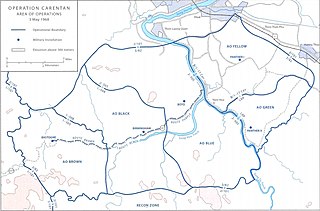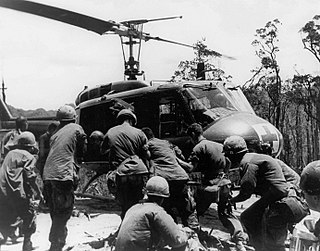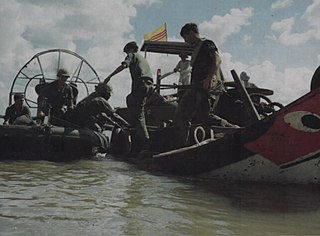
Operation Carentan and Operation Carentan II were security operations conducted during the Vietnam War by the U.S. 1st and 2nd Brigades, 101st Airborne Division and the 3rd Brigade, 82nd Airborne Division in Thừa Thiên Province, South Vietnam from 18 March to 17 May 1968.

The First Battle of Loc Ninh was a battle during the Vietnam War that occurred between 29 October and 7 November 1967, fought by the Viet Cong, Army of the Republic of Vietnam (ARVN), Civilian Irregular Defense Group and the United States Army.

Operation Apache Snow was a joint U.S. Army and Army of the Republic of Vietnam (ARVN) military operation during the Vietnam War designed to keep pressure on the People's Army of Vietnam (PAVN) units in the A Sầu Valley and prevent them from mounting any attacks on the neighboring coastal provinces.
Operation Shenandoah II was a security operation conducted during the Vietnam War by the U.S. 1st Infantry Division to secure and repair Highway 13, South Vietnam from 29 September to 19 November 1967.
Operation Nevada Eagle was a security operation during the Vietnam War in Thừa Thiên Province, that took place from 17 May 1968 to 28 February 1969.
Operation Iron Mountain was a security operation during the Vietnam War in Quảng Ngãi Province, that took place from 28 February 1969 to 28 February 1971.
Operation Frederick Hill was a security operation during the Vietnam War in Quang Tin Province, that took place from 18 March 1969 to 28 February 1971.
Operation Geneva Park was a security operation during the Vietnam War in Quảng Ngãi Province, that took place from 18 March 1969 to 28 February 1971.
Operation Lamar Plain was a security operation during the Vietnam War in Quảng Tín Province, that took place from 15 May to 14 August 1969.
Operation Montgomery Rendezvous was a security operation during the Vietnam war conducted by the 101st Airborne Division in the area southwest of Huế in western Thừa Thiên Province, from 8 June to 15 August 1969.
Operation Champaign Grove was a security operation during the Vietnam War conducted by elements of the 11th Infantry Brigade in Quảng Ngãi Province from 4 to 24 September 1968.
Operation Fulton Square was a joint U.S. Army and Army of the Republic of Vietnam (ARVN) military operation during the Vietnam War to engage People's Army of Vietnam (PAVN) units in the lowlands of Quảng Trị Province.
Operation Toan Thang III was a U.S. Army and Army of the Republic of Vietnam (ARVN) operation conducted between 17 February and 31 October 1969 in the Vietnam War. The operation was designed to keep pressure on Vietcong (VC) and People's Army of Vietnam (PAVN) forces in III Corps.

Operation Toan Thang II was a U.S. Army and Army of the Republic of Vietnam (ARVN) operation conducted between 1 June 1968 and 16 February 1969 in the Vietnam War. The operation was designed to keep pressure on Vietcong (VC) and People's Army of Vietnam (PAVN) forces in III Corps.
Operation Jeb Stuart III was a U.S. Army operation during the Vietnam War conducted by the 1st Cavalry Division that took place in Quảng Trị and Thừa Thiên Provinces of I Corps, South Vietnam from 17 May to 3 November 1968.
Operation Toan Thang IV was a U.S. Army and Army of the Republic of Vietnam (ARVN) operation conducted between 1 November 1969 and 1 May 1970 in the Vietnam War. The operation was designed to keep pressure on Vietcong (VC) and People's Army of Vietnam (PAVN) forces in III Corps.
Operation MacArthur was a United States Army military operation in the Central Highlands of South Vietnam from 12 October 1967 to 31 January 1969. The early phases of the operation encompassed the Battle of Dak To from 3 to 23 November 1967.
Operation Walker was a security operation conducted during the Vietnam War by the U.S. Army’s 1st Battalion, 503rd Infantry Regiment, 173rd Airborne Brigade in Bình Định Province, South Vietnam from 17 March 1968 to 31 January 1969.
Operation McLain was a security operation conducted during the Vietnam War by the U.S. Army’s 3rd Battalion, 506th Infantry Regiment, 101st Airborne Division and the Army of the Republic of Vietnam (ARVN) 44th Regiment, 23rd Division in Bình Thuận Province, South Vietnam from 20 January 1968 to 31 January 1969.
The DMZ Campaign (1969–71) was a military campaign by the United States Army, United States Marine Corps (USMC) and the Army of the Republic of Vietnam (ARVN) against the People’s Army of Vietnam (PAVN) along the Vietnamese Demilitarized Zone (DMZ) in northern Quảng Trị Province from 1969 to 1971 during the Vietnam War.



